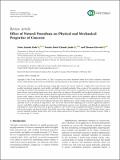Effect of Natural Pozzolana on Physical and Mechanical Properties of Concrete

View/
Date
2024-02-13Author
Fode, Tsion
Jande, Yusufu
Kivevele, Thomas
Metadata
Show full item recordAbstract
Construction industries are rapidly growing, sacking high amounts of concrete which has a highly dense microstructure with
excellent mechanical properties, more durable, and highly eco-friendly materials. Hence, many of the researchers are interested
in solving this problem with replacing concrete by natural pozzolana (NP) which is a supplementary cementitious material mostly
from volcanic sources having much active silica content that can improve the durability and mechanical properties of concrete.
However, it is not well-known which common optimum replacement range can give the most desirable concrete properties. So, the
present study sought to review the effects of replacing NP from volcanic sources on the durability, physical, mechanical, and
microstructural properties of concrete, also, to identify the most common dose of a positive effect as a replacement in concrete. The
review shows that many of NP used by different literature from different places satisfy ASTM replacement standard in concrete,
especially, based on its chemical compositions. Also, the review observed that employing NP in concrete significantly improves
concrete workability, lengthens setting time, and reduces bulk density, porosity, water absorption, and chloride ion migration by
making denser concrete microstructure. In general, adding 5%–20% of NP in concrete significantly improves compressive strength,
split tensile strength, and flexural strength. Specifically, most of the studies found 15% replacement of NP having volcanic sources
can give optimum strength. Besides these, most of the studies indicated that the improvement of the strength was more visible at
the concrete age of 7–28 days.
